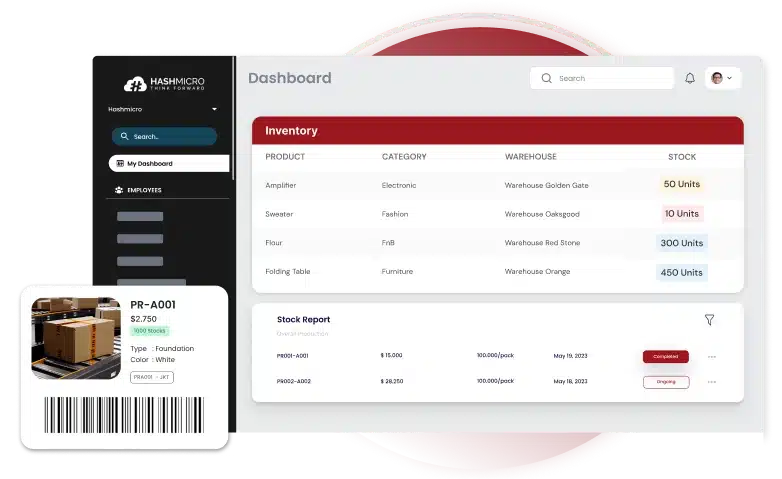In the third quarter of 2022, the occupancy rate for warehouses in Singapore was at 90.8%. This was the highest rate since the third quarter of 2018, despite the COVID-19 pandemic. For 2024, the occupancy rate will get even higher.
However, the bigger problem is that most warehouses do not generate as much value as they could. For instance, on average retail inventory is accurate only 63% of the time due to limited inventory visibility. And when it comes to goods-in-process, human error plagues 46% of warehouses.
That’s why warehouse digitalization is becoming more pronounced and preferred. Fast-growing online brands are turning to “smart” warehouses for their speed, automation, and full visibility. These warehouses boost logistics capabilities while giving brands better control over their supply chain
This article will discuss what a digital warehouse is, how it benefits business, and the necessary tools to enhance storage management for your business.
Key Takeaways
|
Table of Content:
Table of Content
What is Digital Warehouse?
Digital warehouse is the practice of using technology and data to transform the way warehouses work. Instead of relying on manual processes like managing inventory or fulfilling orders, businesses are turning to smarter tools like AI, robotics, and IoT to get the job done more efficiently.
This shift means companies can save time, reduce costs, and get a lot more done. Real-time tracking for accurate inventory, automated sorting and packing, and quicker shipping—all of which help keep things running smoothly with digital solutions.
Furthermore, digital warehousing allows brands to outsource logistics to tech-driven warehouses, often operated by third-party logistics (3PL) providers, also known as fulfillment centers.
Hence, brands can enhance their supply chain without needing to invest in their own infrastructure or warehouse automation.
Benefits of Digital Warehouse
Digital warehouses are transforming business operations, boosting productivity, and simplifying processes. With cutting-edge technology and automation, they drive efficiency and scale like never before, improving performance across the board.
Here are some key benefits of implementing a digital warehouse:
- Increased efficiency
Automation and IoT are game-changers for warehouse operations. With technologies like autonomous forklifts, pallet trucks, and IoT sensors, manual errors are drastically reduced, and fulfillment processes run like clockwork. This boost in efficiency helps businesses handle more volume with fewer headaches. - Cost reduction
Cutting costs is key, and optimized inventory management does just that. Advanced Warehouse Management Systems (WMS) and automation streamline inventory control, slashing storage expenses and speeding up order fulfillment. - Enhanced customer experience
Fast and reliable last-mile delivery is crucial for customer satisfaction. The rise of e-commerce in Southeast Asia has driven the need for improved logistics infrastructure. Companies are adopting platform business models to ensure smoother deliveries, even to hard-to-reach areas. - Scalability and flexibility
Micro storage spaces are a flexible solution for businesses looking to scale quickly. As it happens, the concept of micro-storage spaces is gaining traction in Singapore. These smaller storage hubs allow businesses to scale quickly and adapt to changing market demands. - Improved supply chain visibility
Digital logistics platforms provide better visibility across the supply chain. These tools help businesses navigate complex logistics networks more effectively, ensuring smoother operations from end to end. - Better data analytics
Real-time insights, powered by IoT and WMS, give businesses an edge. With access to up-to-the-minute data on inventory, demand, and supply chain performance, companies can make smarter, faster decisions that keep them ahead of the curve.
Digital Warehouse vs Traditional Warehousing
In traditional warehousing, inventory is received and stored manually until it’s time to fulfill orders. Merchants or warehouse teams handle tracking and restocking by hand, which often leads to inefficiencies.
Without real-time data to guide them, these warehouses can quickly run into issues like order mix-ups and delayed shipping.
Digital warehousing, on the other hand, uses advanced technology to make these processes faster and more efficient. Brands today, especially direct-to-consumer (DTC), are turning to tech-powered 3PL providers to level up their operations.
These fulfillment centers come with built-in automation, real-time tracking, and data-driven insights that make the entire supply chain smoother, faster, and more reliable.
While 3PLs are a popular choice, there are other options on the table, like dropshipping, 4PLs, or on-demand warehousing. Each has its own advantages and trade-offs, depending on what your business needs.
That said, 3PLs have the best return on investment—offering access to multiple fulfillment centers, seamless inventory tracking, and cost savings. Furthermore, with a warehouse management system (WMS) in place, you get consistency, transparency, and hands-on support throughout.
What Does the Future of Digital Warehouse Look Like?
With digital commerce on the rise and technology driving modern business, warehouses are evolving to be smarter, faster, and more efficient. Connected devices and algorithms are now central to transforming sensor data into useful insights, making the digital warehouse a reality.
Here’s how the future of warehousing is shaping up:
Internet of Things (IoT)
By 2025, warehouses will be filled with smart devices, forming a network of real-time asset tracking, condition monitoring, and process automation. These connected devices reduce the need for manual checks and ensure smooth, efficient operations.
For instance, sensors automatically alert managers when stock levels are low or signal when food products are nearing expiration. The manual grind of inventory management is replaced with smarter, faster, and more reliable processes.
Advanced Mobility Solutions
Mobile technology is changing how warehouses operate, replacing desktops with smartphones, handheld devices, and even wearables. Tasks like inventory checks, order fulfillment, and shipping become more streamlined with these mobile tools.
Workers benefit from using smart glasses or voice-activated systems to optimize their movements, while managers can monitor stock and operations on the go through mobile dashboards. This shift makes warehouse operations more responsive and flexible.
Machine Learning & Analytics
With machine learning, warehouses no longer rely on guesswork. Historical data is analyzed to predict future demand, allowing businesses to optimize space and resources more effectively.
Instead of reacting to supply chain issues, companies can plan ahead, using insights from sensors to ensure products are available when needed. It’s about being proactive and improving overall efficiency.
Autonomous Guided Vehicles (AGVs)
AGVs take warehouse automation to the next level, moving goods without human involvement. These vehicles help streamline order fulfillment, reduce errors, and free up labor for other tasks.
Rather than needing constant oversight, AGVs handle complex warehouse routes autonomously, enabling businesses to scale without increasing labor costs. They also provide valuable data about warehouse performance in real time.
Automation & Robotics
Automation and robotics aren’t just about cutting labor costs—they bring speed and precision to the table. Robots efficiently handle tasks like picking and packing, while automation keeps operations running smoothly.
By integrating robotics with real-time data, businesses can tackle supply chain challenges head-on, making adjustments as needed. The result? Faster fulfillment, fewer errors, and a more agile warehouse.
Real-Time Inventory Management
Real-time inventory management with warehouse management software is key to staying competitive. With up-to-the-minute data, businesses have full visibility into their stock, enabling them to respond to changes in customer demand with precision.
This approach doesn’t just improve day-to-day operations—it helps identify trends, avoid stockouts, and ensure the right products are available when needed. Real-time data empowers companies to make smarter, faster decisions.
Optimize Your Digital Warehouse with HashMicro Warehouse Management Software
HashMicro’s Warehouse Management System (WMS) is recognized as one of the top solutions in Singapore, offering a range of features that simplify and boost warehouse operations. It uses advanced tools like RFID, barcode tracking software, and real-time tracking to ensure smooth and accurate management of inventory, picking, and shipping.
The system is designed to grow with your business, making it easy to manage even complex supply chains. HashMicro’s WMS isn’t just efficient—it’s smart, helping you cut costs and streamline your warehouse from end to end.
HashMicro offers these features to maximize your warehouse space and avoid over- or understocking:
- RFID Warehouse Rack Stock In/Out Automation: Automates stock tracking using RFID, providing real-time visibility and reducing manual tasks.
- 3D Warehouse: A digital model showing warehouse layout and inventory, enhancing visualization and management.
- OCR for Receiving: Converts physical documents into digital data, speeding up processes and reducing errors.
- Stock Forecasting: Predicts future demand using sales data and trends, optimizing stock levels.
- Run Rate Reordering Rules: Automates reordering based on real-time demand and historical run rates for stock optimization.
- Stock Optimizer per Warehouse: Optimizes storage capacity and occupancy using data-driven strategies across warehouses.
- Racking Capacity with Putaway Strategy: Suggests optimal item placement for efficient storage and warehouse flow.
- Fast Moving/Slow Moving Stocks Analysis: Identifies fast and slow-moving stock to improve inventory management.
- Pick, Pack, Delivery 3-Step Route Warehousing: Streamlines picking, packing, and shipping to enhance order fulfillment efficiency.
Best of all, it’s user-friendly and works across both mobile and desktop devices, making it a go-to solution for businesses across Singapore. If you’re looking to improve your warehouse efficiency, HashMicro’s WMS is the top choice!
Conclusion
A well-implemented warehouse management system (WMS) can greatly improve efficiency and simplify everyday tasks. Automation helps reduce errors, enhances inventory accuracy, and provides real-time updates on warehouse activities.
By automating processes like tracking inventory, fulfilling orders, and managing storage, and connecting these tasks with other business operations, your warehouse can run more smoothly, speed up order processing, and make better use of space.
HashMicro’s Warehouse Management System is designed to make this easier. With automated inventory control, real-time stock tracking, and optimized storage solutions, it helps reduce costs, improve order accuracy, and ensure on-time deliveries.
Transform your warehouse operations and boost efficiency—schedule a free demo with HashMicro today!
FAQ About Warehouse Costs
-
What does warehousing include?
Warehousing is the process of storing physical inventory for sale or distribution. Warehousing involves temporarily storing bulk products before shipping them to other locations or consumers. It’s a crucial process for businesses managing large inventories.
-
What are the 5S principles of warehousing?
The methods of 5S – sort, set in order, shine, standardize and sustain – are used to improve and maintain an organized environment. The 5S system helps maintain an organized warehouse, while kaizen promotes team collaboration to find solutions for operational improvement.
-
What is a warehousing fee?
Warehousing charges, also known as warehousing costs or warehousing fees, refer to the cost of moving goods into or out of the warehouse and storing them. Warehousing fees cover the cost of moving and storing goods in a warehouse, and these charges vary depending on the warehouse.
-
How do you account for warehousing costs?
Generally, companies may include warehousing costs related to raw materials and work in process inventory as part of inventory costs. Companies treat warehousing costs tied to raw materials and work-in-progress as inventory costs, which become expenses once the inventory is sold.





































